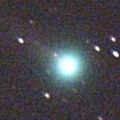
|
Now it is visible in the image of SOHO spacecraft. It is very bright as 2.1 mag (June 26, Mieczyslaw Leszek Paradowski). It approaches to Sun down to 0.3 a.u. on July 3, and brightens up to 0-1 mag. Now it is not observable on the ground. It will appear in the evening sky at 3-4 mag in mid July in the Northern Hemisphere, or at 5 mag in late July in the Southern Hemisphere. Then it stays observable while getting fainter.
Date(TT) R.A. (2000) Decl. Delta r Elong. m1 Best Time(A, h)
June 27 5 55.23 20 40.1 1.346 0.361 7 2.3 5:38 (253,-11)
July 4 6 0.30 30 50.6 1.143 0.295 14 0.9 5:38 (241,-12)
|
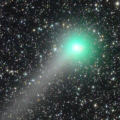
|
Now it is very bright as 6.5 mag (June 24, Marco Goiato). It will be fading after this. In the Southern Hemisphere, it stays observable in good condition for a long time after this. In the Northern Hemisphere, it will appear in the evening sky soon. Then it becomes observable in good condition.
Date(TT) R.A. (2000) Decl. Delta r Elong. m1 Best Time(A, h)
June 27 9 56.01 -5 33.5 0.828 0.926 59 6.3 18:28 (117, 41)
July 4 10 46.98 0 21.6 0.836 0.954 61 6.8 18:30 (127, 40)
|
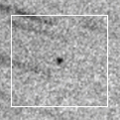
|
It approaches to Sun down to 0.34 a.u. and now it is bright as 7 mag. But it is not observable now. In the Southern Hemisphere, it will appear in the evening sky at 7 mag soon. Then it stays observable in good condition while the comet will be fading. In the Northern Hemisphere, it is not observable until mid August when the comet will fade down to 12 mag.
Date(TT) R.A. (2000) Decl. Delta r Elong. m1 Best Time(A, h)
June 27 7 33.24 20 51.0 1.161 0.338 16 7.3 18:28 (113, -3)
July 4 8 25.43 15 7.9 0.974 0.401 23 7.5 18:30 (112, 5)
|
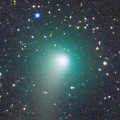
|
Now it is 9.2 mag (July 20, Marco Goiato). It stays observable at 9-10 mag in the evening sky until September.
Date(TT) R.A. (2000) Decl. Delta r Elong. m1 Best Time(A, h)
June 27 12 21.55 44 48.9 1.763 1.765 73 8.6 18:28 (175, 10)
July 4 12 37.08 39 17.3 1.822 1.804 72 8.7 18:30 (171, 15)
|
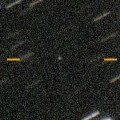
|
Now it is 15.5 mag (June 2, SONEAR Observatory, Oliveira). It was expected to brighten rapidly up to 9.5 mag in June. But actually, it is much fainter than expected. It has finally started brightening in late May. It is not observable in June. It will be observable in good condition after July while the comet will be fading.
Date(TT) R.A. (2000) Decl. Delta r Elong. m1 Best Time(A, h)
June 27 5 8.71 28 58.2 0.577 0.500 17 9.5 5:38 (239, -7)
July 4 4 53.67 28 32.3 0.709 0.507 27 10.0 5:38 (234, 0)
|

|
Recovered from SWAN images after 24-year blank. Now it is 11.1 mag (June 21, Paul Camilleri). It stays 10-11 mag until August. In the Southern Hemisphere, it stays observable in the morning sky for a long time. In the Northern Hemisphere, it is too low to observe until July.
Date(TT) R.A. (2000) Decl. Delta r Elong. m1 Best Time(A, h)
June 27 3 25.47 11 58.1 1.971 1.424 43 10.3 5:38 (236, 22)
July 4 3 47.41 12 33.1 1.971 1.448 45 10.5 5:38 (234, 23)
|
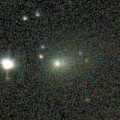
|
Now it is 11.6 mag (June 20, Marco Goiato). Brightening very rapidly. It will brighten up to 8-9 mag from summer to autumn. It will be observable in excellent condition in the Southern Hemisphere. It locates very low around the high light in the Northern Hemisphere.
Date(TT) R.A. (2000) Decl. Delta r Elong. m1 Best Time(A, h)
June 27 12 51.65 -4 50.8 1.189 1.672 98 11.2 18:29 (180, 60)
July 4 12 59.25 -6 4.6 1.210 1.631 93 11.0 18:30 (169, 61)
|

|
It brightened up to 4.7 mag in early May (May 2, Marco Goiato). However, it is fading and getting diffused after that. It has already faded down to 7.3 mag (May 21, Mitsunori Tsumura). It is not observable until August after this.
Date(TT) R.A. (2000) Decl. Delta r Elong. m1 Best Time(A, h)
June 27 6 11.24 32 56.8 1.834 0.852 10 11.3 5:38 (243,-21)
July 4 6 18.71 30 12.9 1.962 0.981 10 12.1 5:38 (244,-15)
|
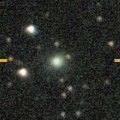
|
Now it is 14.8 mag (June 19, Katsumi Yoshimoto). It is expected to brighten up to 10.5 mag from December to January. In the Northern Hemisphere, it stays observable in good condition while the comet will be brightening gradually, but it is not observable at the high light. In the Southern Hemisphere, it is not observable for a long time, but it will be observable in good condition after the high light. It is fainter than this ephemeris recently.
Date(TT) R.A. (2000) Decl. Delta r Elong. m1 Best Time(A, h)
June 27 11 57.38 58 39.8 2.845 2.618 66 12.9 18:28 (173, -4)
July 4 11 57.36 54 55.5 2.841 2.556 63 12.8 18:30 (168, -1)
|

|
Appearing in the morning sky. Now it is not visible, fainter than 14.4 mag (June 21, Chris Wyatt).
Date(TT) R.A. (2000) Decl. Delta r Elong. m1 Best Time(A, h)
June 27 2 29.86 23 42.4 6.359 5.809 53 13.7 5:38 (217, 21)
July 4 2 34.08 24 10.0 6.271 5.811 58 13.7 5:38 (212, 23)
|
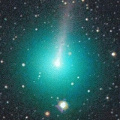
|
It brightened up to 8 mag from March to April. It continued brightening for a while even after the perihelion passage on Mar. 15. But it is fading now. It has already faded down to 13.6 mag (June 21, Paul Camilleri). It seems to be a fragment of C/1988 A1 (Liller), like C/1996 Q1 (Tabur) and C/2015 F3 (SWAN).
Date(TT) R.A. (2000) Decl. Delta r Elong. m1 Best Time(A, h)
June 27 12 4.63 25 52.0 1.905 1.929 75 13.9 18:28 (168, 29)
July 4 12 12.01 21 39.9 2.073 2.021 72 14.4 18:30 (161, 31)
|

|
Now it is 13.5 mag (May 17, Thomas Lehmann). It stays 14 mag until autumn. In the Southern Hemisphere, it will never be observable again.
Date(TT) R.A. (2000) Decl. Delta r Elong. m1 Best Time(A, h)
June 27 3 17.86 80 5.3 4.218 3.814 60 14.1 5:38 (189,-28)
July 4 3 59.15 82 10.8 4.231 3.852 61 14.1 5:38 (187,-30)
|
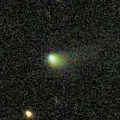
|
Now it is 14.0 mag (June 21, Paul Camilleri). It stays 13-14 mag from 2020 to 2021. It stays observable in good condition for a while.
Date(TT) R.A. (2000) Decl. Delta r Elong. m1 Best Time(A, h)
June 27 12 38.54 10 56.8 2.984 3.134 88 14.2 18:28 (176, 44)
July 4 12 42.61 9 48.2 3.061 3.120 83 14.3 18:30 (167, 44)
|
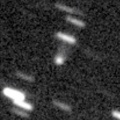
|
Now it is 15.0 mag (June 16, Toshihiko Ikemura, Hirohisa Sato). It will brighten up to 13 mag in 2021. In 2020, it is observable at 15 mag in good condition from spring to summer.
Date(TT) R.A. (2000) Decl. Delta r Elong. m1 Best Time(A, h)
June 27 13 53.87 -22 25.6 4.238 4.805 118 15.0 19:30 (180, 78)
July 4 13 51.98 -22 47.7 4.298 4.766 111 14.9 19:01 (180, 78)
|
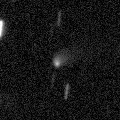
|
Now it is 15.5 mag (June 6, iTelescope Observatory, Siding Spring). It stays 14-15 mag until 2021. In the Southern Hemisphere, it stays observable in good condition for a long time. In the Northern Hemisphere, it is not observable until June in 2021.
Date(TT) R.A. (2000) Decl. Delta r Elong. m1 Best Time(A, h)
June 27 14 33.95 -83 22.4 4.316 4.860 116 15.0 20:12 ( 0, 42)
July 4 14 29.29 -82 44.1 4.306 4.834 115 15.0 19:40 ( 0, 42)
|
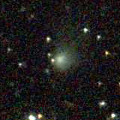
|
Now it is 15.5 mag (June 19, Katsumi Yoshimoto). It is expected to be observable at 5-6 mag for a long time from 2022 to 2023. In the Northern Hemisphere, it is not observable at the high light from 2022 summer to 2023 summer. In the Southern Hemisphere, it is only visible in the extremely low sky in summer in 2020. But it will be observable in good condition at the high light.
Date(TT) R.A. (2000) Decl. Delta r Elong. m1 Best Time(A, h)
June 27 17 35.67 53 4.7 8.572 8.854 102 15.1 23:11 (180, 2)
July 4 17 30.61 52 45.2 8.531 8.803 102 15.1 22:38 (180, 2)
|
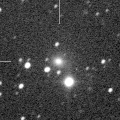
|
Now it is 15.8 mag (June 14, SONEAR Observatory, Oliveira). It stays 15 mag until summer. It stays observable for a long time in the Southern Hemisphere. It is not observable until August in the Northern Hemisphere.
Date(TT) R.A. (2000) Decl. Delta r Elong. m1 Best Time(A, h)
June 27 3 17.73 -35 2.7 4.096 3.924 73 15.2 5:38 (285, 50)
July 4 3 20.62 -34 52.6 4.064 3.955 76 15.2 5:38 (283, 55)
|

|
Now it is 15.1 mag (June 15, Toshihiko Ikemura, Hirohisa Sato). It stays 15-16 mag for a long time until 2021.
Date(TT) R.A. (2000) Decl. Delta r Elong. m1 Best Time(A, h)
June 27 20 9.25 15 8.9 3.712 4.476 133 15.4 1:49 (180, 40)
July 4 19 59.92 16 20.6 3.675 4.477 137 15.3 1:12 (180, 39)
|
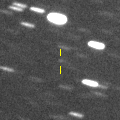
|
Now it is 16.3 mag (June 2, ATLAS-HKO, Haleakala). It will brighten up to 15-16 mag from June to August, and it will be observable in good condition.
Date(TT) R.A. (2000) Decl. Delta r Elong. m1 Best Time(A, h)
June 27 19 22.66 -0 51.0 1.117 2.076 153 15.5 1:02 (180, 56)
July 4 19 20.04 -0 57.1 1.094 2.069 157 15.4 0:32 (180, 56)
|

|
Now it is 16.4 mag (June 2, J. L. Virlichie, P. Traverse). It will brighten up to 13.5 mag in spring in 2021. In the Southern Hemisphere, it stays observable in good condition for a long time. In the Northern Hemisphere, it is not observable until spring in 2021.
Date(TT) R.A. (2000) Decl. Delta r Elong. m1 Best Time(A, h)
June 27 21 55.60 -61 3.8 3.613 4.313 127 15.6 3:36 ( 0, 64)
July 4 21 36.54 -62 50.2 3.532 4.275 131 15.5 2:50 ( 0, 62)
|

|
Now it is very faint as 18-19 mag (June 16, Alan Hale). It was expected to brighten very rapidly, and brighten up to 14.5 mag from August to September. But actually, it is much fainter than predicted. In the Northern Hemisphere, it stays observable for a long time, although it becomes extremely low in early September. In the Southern Hemisphere, it is not observable until late October.
Date(TT) R.A. (2000) Decl. Delta r Elong. m1 Best Time(A, h)
June 27 23 5.93 59 19.8 1.201 1.424 79 15.9 4:44 (180, -4)
July 4 23 23.62 69 56.8 1.160 1.342 75 15.6 4:34 (180,-15)
|

|
Now it is 15.3 mag (June 15, Toshihiko Ikemura, Hirohisa Sato). It will brighten up to 12 mag in winter in 2022. In the Northern Hemisphere, it stays observable in good condition for a long time. In the Southern Hemisphere, it is not observable until 2021 November.
Date(TT) R.A. (2000) Decl. Delta r Elong. m1 Best Time(A, h)
June 27 0 41.45 55 7.4 6.297 6.002 68 16.0 5:38 (186, -1)
July 4 0 45.47 56 10.5 6.189 5.957 72 15.9 5:38 (183, -1)
|

|
Now it is 16.4 mag (June 19, Katsumi Yoshimoto). It will stay at 15 mag for a long time from 2021 to 2022. In the Northern Hemisphere, it stays observable in good condition while brightening gradually. In the Southern Hemisphere, it stays locating low for a long time.
Date(TT) R.A. (2000) Decl. Delta r Elong. m1 Best Time(A, h)
June 27 18 22.13 33 23.4 5.613 6.230 123 16.2 0:02 (180, 22)
July 4 18 15.10 32 45.9 5.578 6.199 123 16.2 23:23 (180, 22)
|
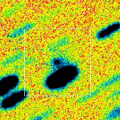
|
Now it is 18.6 mag (June 2, J. L. Virlichie, P. Traverse). It brightens up to 13.5 mag in winter. But it is not observable at high light. In the Southern Hemisphere, it stays observable in good condition until autumn when the comet will brighten up to 14 mag. It stays locating very low in the Northern Hemisphere. It is fainter than this ephemeris recently.
Date(TT) R.A. (2000) Decl. Delta r Elong. m1 Best Time(A, h)
June 27 18 30.20 -46 57.6 1.750 2.712 156 16.4 0:11 ( 0, 78)
July 4 18 21.70 -46 34.2 1.724 2.683 155 16.2 23:30 ( 0, 78)
|
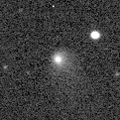
|
It brightened up to 13.8 mag in autumn in 2019 (Sept. 3, Chris Wyatt). Now it is fading slowly. Now it is 16.0 mag (June 20, Toshihiko Ikemura, Hirohisa Sato). In 2020, it stays observable in good condition while the comet will be fading from 16 to 17 mag.
Date(TT) R.A. (2000) Decl. Delta r Elong. m1 Best Time(A, h)
June 27 0 39.98 -1 1.7 5.759 5.791 86 16.4 5:38 (198, 55)
July 4 0 40.34 -0 34.7 5.687 5.832 93 16.4 5:38 (186, 55)
|

|
Now it is 17.6 mag (June 16, Toshihiko Ikemura, Hirohisa Sato). Small comet. But it will approach to Sun down to 0.47 a.u. in September, and it is expected to brighten up to 11 mag. It stays observable in good condition until late August while the comet will be brightening up to 11 mag.
Date(TT) R.A. (2000) Decl. Delta r Elong. m1 Best Time(A, h)
June 27 23 57.01 23 13.6 1.402 1.684 86 17.0 5:35 (180, 32)
July 4 0 17.80 25 14.0 1.238 1.572 87 16.4 5:29 (180, 30)
|

|
It brightened up to 13.2 mag from spring to autumn in 2019 (June 30, Thomas Lehmann). Now it is fading slowly. It has already faded down to 16.3 mag (June 7, ATLAS-MLO, Mauna Loa). In the Southern Hemisphere, it stays observable for a long time. In the Northern Hemisphere, it stays low for a long time.
Date(TT) R.A. (2000) Decl. Delta r Elong. m1 Best Time(A, h)
June 27 0 8.44 -30 14.0 3.856 4.230 104 16.5 5:38 (203, 85)
July 4 0 5.47 -30 18.8 3.796 4.269 111 16.6 5:17 (180, 85)
|

|
Now it is 15.6 mag (May 22, ATLAS-MLO, Mauna Loa). It is observable at 16 mag in 2020. It is observable in excellent condition in the Southern Hemisphere. It locates somewhat low in the Northern Hemisphere.
Date(TT) R.A. (2000) Decl. Delta r Elong. m1 Best Time(A, h)
June 27 19 11.50 -29 28.7 5.712 6.709 167 16.6 0:52 (180, 84)
July 4 19 3.56 -29 18.2 5.712 6.723 173 16.6 0:16 (180, 84)
|

|
Now it is 16.8 mag (May 28, Toshihiko Ikemura, Hirohisa Sato). It will be observable at 16.5-17 mag from spring in 2020 to summer in 2021.
Date(TT) R.A. (2000) Decl. Delta r Elong. m1 Best Time(A, h)
June 27 18 45.82 22 49.5 3.990 4.748 133 16.6 0:26 (180, 32)
July 4 18 35.01 22 0.7 3.963 4.736 134 16.6 23:42 (180, 33)
|

|
Now it is 17.0 mag (May 29, Ken-ichi Kadota). It will brighten up to 16.5 mag and will be observable in good condition from June to October.
Date(TT) R.A. (2000) Decl. Delta r Elong. m1 Best Time(A, h)
June 27 20 35.86 15 6.9 1.426 2.220 129 16.7 2:15 (180, 40)
July 4 20 34.63 16 7.4 1.377 2.206 133 16.6 1:46 (180, 39)
|

|
Fragment of C/1844 Y1 (Great Comet). It brightened up to 7.0 mag in late March ((Mar. 30, Charles S. Morris). But the nucleus was split into some fragments, and it faded out after that. It was 9.1 mag in mid May (May 17, Sandor Szabo). It approached to Sun down to 0.25 a.u. on May 31. In the Northern Hemisphere, it is not observable after this. In the Southern Hemisphere, it is appearing in the morning sky, but it locates extremely low.
Date(TT) R.A. (2000) Decl. Delta r Elong. m1 Best Time(A, h)
June 27 5 27.95 3 41.6 1.627 0.810 23 16.6 5:38 (262, 4)
July 4 5 47.54 3 5.2 1.777 0.962 25 17.6 5:38 (262, 6)
|
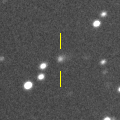
|
Now it is 16.8 mag (June 10, ATLAS-HKO, Haleakala). It stays observable at 16-17 mag from 2020 to 2021. It locates somewhat low in the Northern Hemisphere.
Date(TT) R.A. (2000) Decl. Delta r Elong. m1 Best Time(A, h)
June 27 10 59.37 -15 17.8 6.735 6.591 77 16.8 18:28 (121, 58)
July 4 11 3.27 -15 5.0 6.836 6.593 72 16.9 18:30 (114, 53)
|
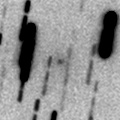
|
Now it is 17.3 mag (June 15, Toshihiko Ikemura, Hirohisa Sato). It brightens up to 17 mag from June to July. It is observable in excellent condition in the Northern Hemisphere. In the Southern Hemisphere, it is not observable until August.
Date(TT) R.A. (2000) Decl. Delta r Elong. m1 Best Time(A, h)
June 27 22 13.83 62 18.1 1.412 1.638 83 16.9 3:55 (180, -7)
July 4 20 52.21 66 23.7 1.352 1.662 87 16.9 2:07 (180,-11)
|

|
Now it is 17.7 mag (June 13, J. L. Virlichie, P. Traverse). It brightens up to 16 mag from summer to winter. In the Southern Hemisphere, it is observable in excellent condition. In the Northern Hemisphere, it is not observable until late October.
Date(TT) R.A. (2000) Decl. Delta r Elong. m1 Best Time(A, h)
June 27 22 21.71 -59 45.1 1.383 2.138 125 17.1 4:01 ( 0, 65)
July 4 22 27.27 -61 40.4 1.312 2.088 127 17.0 3:39 ( 0, 63)
|
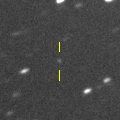
|
Now it is 17.7 mag (May 26, ATLAS-MLO, Mauna Loa). It stays observable at 16-17 mag for a long time until 2024.
Date(TT) R.A. (2000) Decl. Delta r Elong. m1 Best Time(A, h)
June 27 15 36.64 -15 49.6 9.013 9.813 139 17.2 21:13 (180, 71)
July 4 15 33.20 -15 34.0 9.080 9.796 132 17.2 20:42 (180, 71)
|

|
It will pass the perihelion in 2021, and it is predicted to be observable at 17-18 mag from 2020 to 2022. However, it has not been observed at all since 2015. It was not detected, fainter than 20.5 mag, in 2017 May (Werner Hasubick).
Date(TT) R.A. (2000) Decl. Delta r Elong. m1 Best Time(A, h)
June 27 20 37.31 -22 0.9 5.085 5.982 149 17.3 2:17 (180, 77)
July 4 20 35.22 -22 6.1 5.025 5.970 156 17.3 1:47 (180, 77)
|
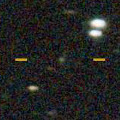
|
Now it is 17.1 mag (June 10, ATLAS-HKO, Haleakala). It became brighter than orignally predicted. It stays observable at 17 mag in good condition until autumn.
Date(TT) R.A. (2000) Decl. Delta r Elong. m1 Best Time(A, h)
June 27 12 54.90 -10 13.7 1.734 2.172 101 17.3 18:32 (180, 65)
July 4 13 1.98 -11 7.1 1.794 2.157 96 17.3 18:30 (169, 66)
|
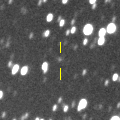
|
Now it is 17.3 mag (Apr. 23, D. Buczynski). It will be observable at 16.5-17 mag from 2020 to 2021. In the Southern Hemisphere, it is not observable until summer in 2021.
Date(TT) R.A. (2000) Decl. Delta r Elong. m1 Best Time(A, h)
June 27 2 4.95 69 59.2 6.650 6.198 59 17.4 5:38 (191,-18)
July 4 2 3.65 70 36.6 6.585 6.184 62 17.3 5:38 (188,-17)
|

|
It brightened up to 12-13 mag from 2018 to 2019. Now it is fading. It has already faded down to 17.1 mag (June 2, J. L. Virlichie, P. Traverse). In the Southern Hemisphere, it stays observable in good condition for a long time. It will never be observable after this in the Northern Hemisphere.
Date(TT) R.A. (2000) Decl. Delta r Elong. m1 Best Time(A, h)
June 27 9 20.56 -58 55.9 5.631 5.721 89 17.3 18:28 ( 38, 48)
July 4 9 23.86 -58 9.8 5.733 5.768 86 17.4 18:30 ( 40, 45)
|

|
Now it is 17.8 mag (June 14, Charles S. Morris). It will fade out after this, and will be fainter than 18 mag in July.
Date(TT) R.A. (2000) Decl. Delta r Elong. m1 Best Time(A, h)
June 27 13 7.39 -4 42.5 1.676 2.130 101 17.5 18:45 (180, 60)
July 4 13 16.02 -5 34.7 1.756 2.140 97 17.7 18:30 (178, 61)
|
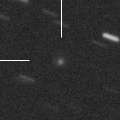
|
It brigthened up to 16.5 mag in May (May 14, R. Ligustir). It is fading rapidly after that. It has already faded down to 18.8 mag (June 16, Toshihiko Ikemura, Hirohisa Sato).
Date(TT) R.A. (2000) Decl. Delta r Elong. m1 Best Time(A, h)
June 27 14 58.43 -0 48.0 3.081 3.761 125 17.6 20:35 (180, 56)
July 4 14 56.75 -1 47.5 3.199 3.797 119 17.7 20:06 (180, 57)
|
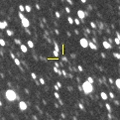
|
Now it is 19.9 mag (May 29, Toshihiko Ikemura, Hirohisa Sato). It stays observable at 18 mag for a long time from 2019 to 2021. However, it is much fainter than this ephemeris recently.
Date(TT) R.A. (2000) Decl. Delta r Elong. m1 Best Time(A, h)
June 27 18 56.03 -20 34.4 6.693 7.701 172 17.6 0:36 (180, 76)
July 4 18 52.23 -21 10.6 6.689 7.705 178 17.6 0:05 (180, 76)
|

|
Now it is 17.1 mag (May 30, ATLAS-MLO, Mauna Loa). It will brighten up to 15.5 mag in early 2021. In 2020, it stays observable at 17 mag until November in the Southern Hemisphere, or until July in the Northern Hemisphere.
Date(TT) R.A. (2000) Decl. Delta r Elong. m1 Best Time(A, h)
June 27 13 58.50 -30 0.8 2.534 3.181 121 17.6 19:35 (180, 85)
July 4 13 57.87 -29 34.5 2.563 3.126 114 17.6 19:07 (180, 85)
|

|
Now it is 17.6 mag (May 28, Hiroshi Abe). It will be fading slowly after this. It is observable in good condition in the Northern Hemisphere. In the Southern Hemisphere, it is observable in the extremely low sky only in 2021 spring.
Date(TT) R.A. (2000) Decl. Delta r Elong. m1 Best Time(A, h)
June 27 12 37.65 48 37.5 9.129 8.917 74 17.7 18:28 (178, 6)
July 4 12 38.62 47 44.6 9.211 8.931 70 17.7 18:30 (173, 7)
|

|
Now it is 17.4 mag (June 19, Katsumi Yoshimoto). Taras Prystavski detected its cometary activity on June 17. It will brighten up to 15.5 mag from spring to summer in 2021. In the Southern Hemisphere, it stays observable in excellent condition for a long time. In the Northern Hemisphere, it is observable in good condition in 2020, however, it will be unobservable in 2021.
Date(TT) R.A. (2000) Decl. Delta r Elong. m1 Best Time(A, h)
June 27 23 21.42 9 14.0 3.709 4.020 100 17.9 5:00 (180, 46)
July 4 23 19.76 8 23.5 3.541 3.971 107 17.7 4:31 (180, 46)
|
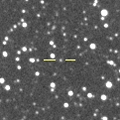
|
Now it is 17.5 mag (June 1, ATLAS-MLO, Mauna Loa). It is observable at 17-18 mag in good condition in 2020 summer.
Date(TT) R.A. (2000) Decl. Delta r Elong. m1 Best Time(A, h)
June 27 19 39.72 30 43.9 8.347 8.941 122 17.8 1:19 (180, 24)
July 4 19 35.71 31 11.4 8.313 8.934 124 17.8 0:48 (180, 24)
|

|
It has not been observed yet in this apparition. It is expected to brighten up to 15 mag from October to November, and it will be observable in excellent condition.
Date(TT) R.A. (2000) Decl. Delta r Elong. m1 Best Time(A, h)
June 27 23 23.93 -31 45.7 1.407 2.046 114 18.1 5:03 (180, 87)
July 4 23 33.93 -32 8.8 1.305 1.996 118 17.9 4:45 (180, 87)
|

|
Now it is 18.6 mag (May 30, ATLAS-MLO, Mauna Loa). It stays 18-19 mag for a long time from 2018 to 2020.
Date(TT) R.A. (2000) Decl. Delta r Elong. m1 Best Time(A, h)
June 27 20 59.66 -34 40.0 3.681 4.546 144 17.9 2:39 (180, 90)
July 4 20 55.58 -34 44.5 3.636 4.551 150 17.9 2:08 (180, 90)
|
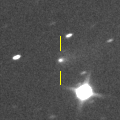
|
It brightened up to 15.9 mag in spring (Mar. 17, Purple Mountain Observatory, XuYi Station). Now it is fading. It has already faded down to 17.6 mag (May 29, ATLAS-HKO, Haleakala). It will be fainter than 18 mag in late June.
Date(TT) R.A. (2000) Decl. Delta r Elong. m1 Best Time(A, h)
June 27 13 18.55 -4 22.9 1.906 2.370 104 17.9 18:56 (180, 60)
July 4 13 24.98 -5 22.3 2.004 2.391 99 18.1 18:34 (180, 61)
|
|
![]()
 C/2020 H4 ( Leonard )
C/2020 H4 ( Leonard ) C/2019 L3 ( ATLAS )
C/2019 L3 ( ATLAS ) C/2018 U1 ( Lemmon )
C/2018 U1 ( Lemmon ) 17P/Holmes
17P/Holmes C/2017 B3 ( LINEAR )
C/2017 B3 ( LINEAR ) C/2020 K8 ( Catalina-ATLAS )
C/2020 K8 ( Catalina-ATLAS ) C/2018 A6 ( Gibbs )
C/2018 A6 ( Gibbs ) C/2017 U7 ( PanSTARRS )
C/2017 U7 ( PanSTARRS ) C/2017 Y2 ( PanSTARRS )
C/2017 Y2 ( PanSTARRS ) 257P/Catalina
257P/Catalina C/2019 Y4 ( ATLAS )
C/2019 Y4 ( ATLAS ) C/2019 C1 ( ATLAS )
C/2019 C1 ( ATLAS ) C/2020 K3 ( Leonard )
C/2020 K3 ( Leonard ) 162P/Siding Spring
162P/Siding Spring C/2020 F2 ( ATLAS )
C/2020 F2 ( ATLAS ) C/2014 F3 ( Sheppard-Trujillo )
C/2014 F3 ( Sheppard-Trujillo ) 278P/McNaught
278P/McNaught C/2019 T3 ( ATLAS )
C/2019 T3 ( ATLAS ) C/2017 M4 ( ATLAS )
C/2017 M4 ( ATLAS ) 87P/Bus
87P/Bus P/2019 LM4 ( Palomar )
P/2019 LM4 ( Palomar ) C/2017 K5 ( PanSTARRS )
C/2017 K5 ( PanSTARRS ) 28P/Neujmin 1
28P/Neujmin 1 C/2010 U3 ( Boattini )
C/2010 U3 ( Boattini ) A/2019 T2
A/2019 T2 A/2019 O3
A/2019 O3 156P/Russell-LINEAR
156P/Russell-LINEAR 186P/Garradd
186P/Garradd P/2019 Y2 ( Fuls )
P/2019 Y2 ( Fuls )![]()







































